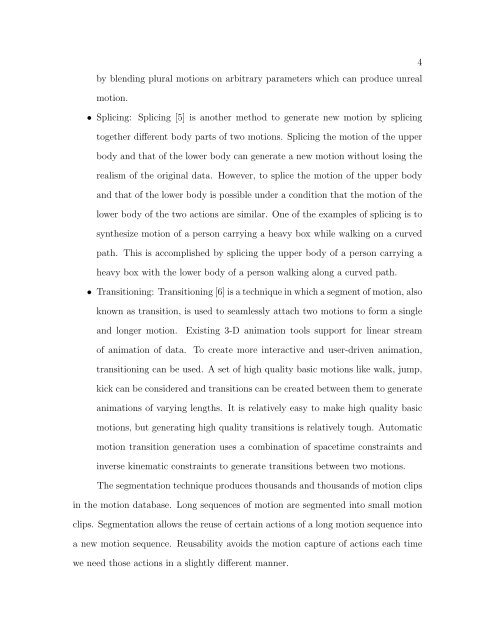A COMPARISON AND EVALUATION OF MOTION INDEXING ...
A COMPARISON AND EVALUATION OF MOTION INDEXING ...
A COMPARISON AND EVALUATION OF MOTION INDEXING ...
Create successful ePaper yourself
Turn your PDF publications into a flip-book with our unique Google optimized e-Paper software.
y blending plural motions on arbitrary parameters which can produce unreal<br />
motion.<br />
• Splicing: Splicing [5] is another method to generate new motion by splicing<br />
together different body parts of two motions. Splicing the motion of the upper<br />
body and that of the lower body can generate a new motion without losing the<br />
realism of the original data. However, to splice the motion of the upper body<br />
and that of the lower body is possible under a condition that the motion of the<br />
lower body of the two actions are similar. One of the examples of splicing is to<br />
synthesize motion of a person carrying a heavy box while walking on a curved<br />
path. This is accomplished by splicing the upper body of a person carrying a<br />
heavy box with the lower body of a person walking along a curved path.<br />
• Transitioning: Transitioning [6] is a technique in which a segment of motion, also<br />
known as transition, is used to seamlessly attach two motions to form a single<br />
and longer motion. Existing 3-D animation tools support for linear stream<br />
of animation of data. To create more interactive and user-driven animation,<br />
transitioning can be used. A set of high quality basic motions like walk, jump,<br />
kick can be considered and transitions can be created between them to generate<br />
animations of varying lengths. It is relatively easy to make high quality basic<br />
motions, but generating high quality transitions is relatively tough. Automatic<br />
motion transition generation uses a combination of spacetime constraints and<br />
inverse kinematic constraints to generate transitions between two motions.<br />
The segmentation technique produces thousands and thousands of motion clips<br />
in the motion database. Long sequences of motion are segmented into small motion<br />
clips. Segmentation allows the reuse of certain actions of a long motion sequence into<br />
a new motion sequence. Reusability avoids the motion capture of actions each time<br />
we need those actions in a slightly different manner.<br />
4
















